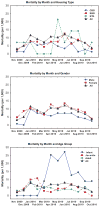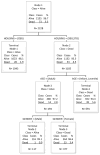Risk factor analysis may provide clues to diarrhea prevention in outdoor-housed rhesus macaques (Macaca mulatta)
- PMID: 23568382
- PMCID: PMC3956043
- DOI: 10.1002/ajp.22150
Risk factor analysis may provide clues to diarrhea prevention in outdoor-housed rhesus macaques (Macaca mulatta)
Abstract
Seventy-five percent of rhesus macaques at national primate research centers are housed outside. Annually, 15-39% of these animals experience diarrhea and require veterinary treatment for dehydration, electrolyte imbalance, or weight loss. An estimated 21-33% of these patients will die or be euthanized. Many studies have explored the various infectious etiologies of non-human primate diarrhea. However, there is little published information on diarrhea incidence rates and risk factors in outdoor-housed rhesus macaques. Without this information, it is challenging to determine endemic and epidemic diarrhea levels, or to develop and evaluate mitigation strategies. Using electronic medical records, we conducted a retrospective cohort study to calculate diarrhea incidence rates for rhesus macaques (N = 3,181) housed in three different outdoor housing types (corrals, shelters, and temporary housing) at the Oregon National Primate Research Center between November 1, 2009 and October 31, 2010. With multiple logistic regression analysis, we determined the relative risk of housing type, sex, and age on development of diarrhea. Diarrhea incidence and mortality in our population was lower than many published ranges. Type of outdoor housing, age, and previous diarrhea episode were positively correlated with diarrhea risk. Younger animals in smaller shelters and temporary housing had a greater risk of acquiring diarrhea, with juvenile animals (0.7-3.9 years) having the highest mortality rate. Sex was not a risk factor, but adult females with diarrhea were more likely to develop life-threatening complications than adult males. We also constructed a predictive model for diarrhea-associated mortality using Classification and Regression Tree. Findings from this study will be used to develop and evaluate mitigation strategies in our outdoor-housed population and to provide a foundation for genetic susceptibility and immune function testing.
© 2013 Wiley Periodicals, Inc.
Figures






Similar articles
-
Rotavirus is associated with decompensated diarrhea among young rhesus macaques (Macaca mulatta).Am J Primatol. 2019 Jan;81(1):e22948. doi: 10.1002/ajp.22948. Epub 2019 Jan 8. Am J Primatol. 2019. PMID: 30620103 Free PMC article.
-
Reproductive performance of rhesus macaques (Macaca mulatta) in two outdoor housing conditions.Am J Primatol. 2000 Jan;50(1):87-93. doi: 10.1002/(SICI)1098-2345(200001)50:1<87::AID-AJP8>3.0.CO;2-N. Am J Primatol. 2000. PMID: 10588438
-
Effect of Indoor Compared with Outdoor Location during Gestation on the Incidence of Diarrhea in Indoor-Reared Rhesus Macaques (Macaca mulatta).J Am Assoc Lab Anim Sci. 2016;55(3):277-90. J Am Assoc Lab Anim Sci. 2016. PMID: 27177560 Free PMC article.
-
Social management of laboratory rhesus macaques housed in large groups using a network approach: A review.Behav Processes. 2018 Nov;156:77-82. doi: 10.1016/j.beproc.2017.11.014. Epub 2017 Dec 7. Behav Processes. 2018. PMID: 29224844 Free PMC article. Review.
-
Laboratory rhesus macaque social housing and social changes: Implications for research.Am J Primatol. 2017 Jan;79(1):1-14. doi: 10.1002/ajp.22528. Epub 2016 Feb 5. Am J Primatol. 2017. PMID: 26848542 Free PMC article. Review.
Cited by
-
Common and Not-So-Common Pathologic Findings of the Gastrointestinal Tract of Rhesus and Cynomolgus Macaques.Toxicol Pathol. 2022 Jul;50(5):638-659. doi: 10.1177/01926233221084634. Epub 2022 Apr 1. Toxicol Pathol. 2022. PMID: 35363082 Free PMC article. Review.
-
Enteric Viruses Nucleic Acids Distribution along the Digestive Tract of Rhesus Macaques with Idiopathic Chronic Diarrhea.Viruses. 2022 Mar 19;14(3):638. doi: 10.3390/v14030638. Viruses. 2022. PMID: 35337045 Free PMC article.
-
Idiopathic Chronic Diarrhea in Rhesus Macaques Is Not Associated with Enteric Viral Infections.Viruses. 2021 Dec 14;13(12):2503. doi: 10.3390/v13122503. Viruses. 2021. PMID: 34960771 Free PMC article.
-
Growth faltering regardless of chronic diarrhea is associated with mucosal immune dysfunction and microbial dysbiosis in the gut lumen.Mucosal Immunol. 2021 Sep;14(5):1113-1126. doi: 10.1038/s41385-021-00418-2. Epub 2021 Jun 22. Mucosal Immunol. 2021. PMID: 34158595 Free PMC article.
-
Standard growth and diarrhea-associated growth faltering in captive infant rhesus macaques (Macaca mulatta).Am J Primatol. 2018 Sep;80(9):e22923. doi: 10.1002/ajp.22923. Epub 2018 Oct 3. Am J Primatol. 2018. PMID: 30281825 Free PMC article.
References
-
- Blanchard JL, Baskin GB, Watson EA. Generalized amyloidosis in rhesus monkeys. Vet Pathol. 1986;23:425–430. - PubMed
-
- Breiman L, Friedman JH, Olshen R, Stone C. Classification and Regression Trees. Belmont (CA): Wadsworth; 1984. p. 368.
-
- Desrosiers RC. The value of specific pathogen-free rhesus monkey breeding colonies for AIDS research. AIDS Res Hum Retroviruses. 1997;13:5–6. - PubMed
-
- Elfenbein HA, McCowan B. The epidemiology of non-pathogenic diarrhea in captive rhesus macaques. J Am Assoc Lab Anim Sci. 2012;52:100.
-
- Elmore DB, Anderson JH, Hird DW, Sanders KD, Lerche NW. Diarrhea rates and risk factors for developing chronic diarrhea in infant and juvenile rhesus monkeys. Lab Anim Sci. 1992;42:356–359. - PubMed
Publication types
MeSH terms
Grants and funding
LinkOut - more resources
Full Text Sources
Other Literature Sources
Medical

